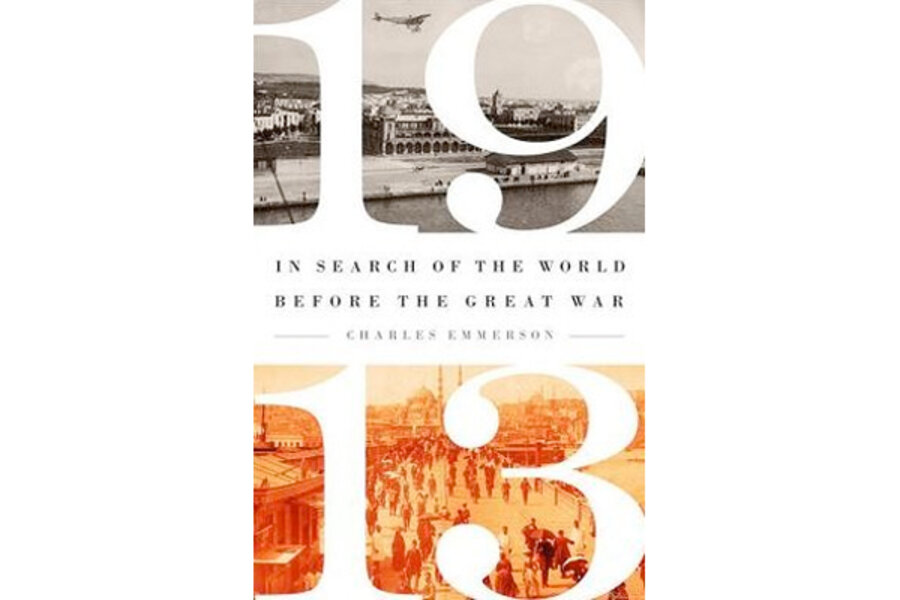1913: In Search of the World Before the Great War
Loading...
It’s easy to forget that history is not preordained. To the modern eye, a pall hangs over 1913; 1938; October 1963; and August 2001. In our imaginations, we see the people living through those years marching inevitably towards sweeping changes about to permanently transform the world order.
But in 1913: In Search of the World Before the Great War, historian and geopolitical specialist Charles Emmerson sets out to paint a picture of 1913 as it was, rather than as simply a prelude to World War I. In his sweeping travelogue, which takes the reader from London to Durban, Detroit to Winnipeg, Algiers to Tokyo, Emmerson shows that the Great War was far from inevitable and that the optimism, ideas, and global interconnectedness of 1913 could have led the world down another path, had history taken a different turn.
Citizens of most countries and empires around the world had reasons to be optimistic in 1913. Europe, the continent that would tear itself apart the next year, was united across national borders: The upper classes shared tastes in art, culture and music, while workers shared their socialist principles and women shared their desire for universal suffrage. Non-European cities were enjoying unprecedented success: Tokyo was the center of a rapidly modernizing and industrializing country that was considered by some to be the England of the East. Buenos Aires, fueled by wealth generated from large-scale industrial farming, was becoming a grand city that attracted cultural events such as the Ballets Russe. Detroit’s star was rising as its automobile production inaugurated a culture of mass consumerism and middle class luxury.
It’s difficult to avoid viewing some of Emmerson’s examples through the lens of the present. In 1913, the Ottoman Empire’s modernization programs led some to wonder whether that failing empire might revitalize itself in subsequent years, but by the end of the Great War, that empire was gone. In 1913, Kaiser Wilhelm stopped the Habsburgs from involving Austro-Hungary in the Balkan war, leading newspapers around the world to declare that history would remember him as a great peacemaker – and yet five years later, he abdicated to the Netherlands as his country descended into revolution. And at the end of 1913, the Economist staunchly predicted that all signs pointed towards peace for the immediate future – an obviously poor prediction.
Emmerson reminds the reader that alongside the optimism of 1913, darker forces such as political unrest, violence, and racism also existed. In China, uncertainty after the end of 2,000 years of dynastic rule led to assassinations of political figures. In London, suffragettes protested the disenfranchisement of women by planting bombs and throwing themselves in front of horses. In Russia, a Jewish clerk was tried on the bogus charge of ritualistically drinking Christian babies’ blood. Racial tensions beset South Africa and California passed a law prohibiting Japanese immigrants from owning land in their state. The British Empire struggled to define its relationship with its colonies and the Ottomans and the Japanese wondered if they would have to compromise their cultures by adopting Western norms to try to earn European respect.
Emmerson’s book is to some extent a travelogue of the world of 1913. His descriptions of the physical features of the cities where key events of that year played out transport the reader from the coast of Bombay – a city that smelled of musk, spices and sandalwood – to the ramshackle streets on the south side of Constantinople – where frail houses teetered next to imposing mosques – to the boulevards of Berlin, where visitors found gleaming signs of modernity such as telephones and trams.
At some points in Emmerson’s narrative, his travelogue seems too broad in scope, as though he covered too much geographical space in one volume. As he describes each of the 23 cities in the book, it’s sometimes easy to forget his larger purpose. And yet Emmerson’s project would not be as compelling if he had simply focused on Europe, or on England and her colonies. The Great War was truly a global war, and the world of 1913 was truly a global society. In his book, Emmerson gives fair weight to societies around the world rather than presenting the year from a Eurocentric point of view.
Of course, despite all the alternate paths history could have taken, war did tear apart the world in 1914. Emmerson does not touch on the causes of the war in his book, but in his epilogue – perhaps the most compelling part of his narrative – he reminds us of the horrors that the war wrought and calls on us to use the story of 1913 as a cautionary tale. The bloody horrors of the 20th century were not inevitable, he reminds us, and we would do well to remember that when considering our own present and thinking about how we want to shape our future.
Emily Cataneo is a journalist and book critic based in Boston.








